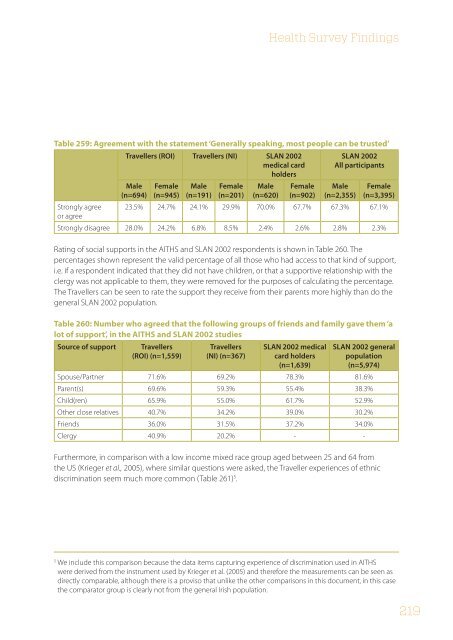- Page 1:
All IrelandTraveller Health StudyOu
- Page 4:
All Ireland Traveller Health StudyA
- Page 7 and 8:
Health Survey FindingsRegion Travel
- Page 9:
Health Survey FindingsRegion Travel
- Page 12 and 13:
All Ireland Traveller Health StudyR
- Page 15 and 16:
Health Survey FindingsRegion Travel
- Page 17 and 18:
Health Survey FindingsRegion Resear
- Page 19 and 20:
Health Survey FindingsTravellers in
- Page 21 and 22:
Health Survey FindingsMAPPING AND S
- Page 23 and 24:
Health Survey FindingsSMOKING, ALCO
- Page 25 and 26:
Health Survey FindingsList of Table
- Page 27 and 28:
Health Survey FindingsTABLE 39: SUM
- Page 29 and 30:
Health Survey FindingsTABLE 73:TABL
- Page 31 and 32:
Health Survey FindingsTABLE 104:TAB
- Page 33 and 34:
Health Survey FindingsTABLE 134:TAB
- Page 35 and 36:
Health Survey FindingsTABLE 166:IN
- Page 37 and 38:
Health Survey FindingsTABLE 199:TAB
- Page 39 and 40:
Health Survey FindingsTABLE 226:TAB
- Page 41 and 42:
Health Survey FindingsTABLE 259:TAB
- Page 43 and 44:
Health Survey FindingsNINISRANITNNL
- Page 45 and 46:
Health Survey FindingsBackground to
- Page 47 and 48:
Health Survey FindingsStudy Aims an
- Page 49 and 50:
Health Survey FindingsThe key healt
- Page 51 and 52:
Health Survey FindingsFigure 2: Pop
- Page 53 and 54:
Health Survey FindingsIn 2004 NTACC
- Page 55 and 56:
Health Survey FindingsThe general r
- Page 57 and 58:
Health Survey FindingsThe public po
- Page 59 and 60:
Health Survey FindingsThe review bo
- Page 61 and 62:
Health Survey FindingsFigure 4: Fra
- Page 63 and 64:
Health Survey FindingsPerceptions o
- Page 65 and 66:
Health Survey FindingsThe NACD repo
- Page 67 and 68:
Health Survey FindingsNorthern Irel
- Page 69 and 70:
Health Survey FindingsThe Primary H
- Page 71 and 72:
Health Survey FindingsReplication a
- Page 73 and 74:
Health Survey FindingsTechnical Ste
- Page 75 and 76:
Health Survey FindingsTable 1: Trav
- Page 77 and 78:
Health Survey FindingsFigure 6: Tra
- Page 79 and 80:
Health Survey FindingsThe terms of
- Page 81 and 82:
Health Survey FindingsThe Primary H
- Page 83 and 84:
Health Survey FindingsNorthern Irel
- Page 85 and 86:
Health Survey FindingsEthical Appro
- Page 87 and 88:
Health Survey FindingsStudy Methodo
- Page 89 and 90:
Health Survey FindingsSub-StudiesTh
- Page 91 and 92:
Health Survey FindingsMapping and S
- Page 93 and 94:
Health Survey FindingsMapping and S
- Page 95 and 96:
Health Survey FindingsRegionTable 3
- Page 97 and 98:
Health Survey Findings• cultural
- Page 99 and 100:
Health Survey FindingsSoftware Prep
- Page 101 and 102:
Health Survey FindingsPeer Research
- Page 103 and 104:
Health Survey FindingsTitle and Bra
- Page 105 and 106:
Health Survey FindingsData Collecti
- Page 107 and 108:
Health Survey FindingsAnalysis Stra
- Page 109 and 110:
Health Survey Findingsthe classific
- Page 111 and 112:
Health Survey FindingsSurvey Respon
- Page 113 and 114:
Health Survey FindingsFigure 10: Re
- Page 115 and 116:
Health Survey FindingsResults71
- Page 117 and 118:
Health Survey FindingsTable 7: Econ
- Page 120 and 121:
All Ireland Traveller Health StudyS
- Page 122 and 123:
All Ireland Traveller Health StudyT
- Page 124 and 125:
All Ireland Traveller Health StudyT
- Page 126 and 127:
All Ireland Traveller Health StudyT
- Page 128 and 129:
All Ireland Traveller Health Study8
- Page 130 and 131:
All Ireland Traveller Health StudyT
- Page 132 and 133:
All Ireland Traveller Health StudyT
- Page 134 and 135:
All Ireland Traveller Health StudyT
- Page 136 and 137:
All Ireland Traveller Health StudyT
- Page 138 and 139:
All Ireland Traveller Health StudyT
- Page 140 and 141:
All Ireland Traveller Health Study9
- Page 142 and 143:
All Ireland Traveller Health StudyT
- Page 144 and 145:
All Ireland Traveller Health Study6
- Page 146 and 147:
All Ireland Traveller Health Study1
- Page 148 and 149:
All Ireland Traveller Health StudyS
- Page 150 and 151:
All Ireland Traveller Health StudyM
- Page 152 and 153:
All Ireland Traveller Health StudyT
- Page 154 and 155:
All Ireland Traveller Health StudyT
- Page 156 and 157:
All Ireland Traveller Health StudyM
- Page 158 and 159:
All Ireland Traveller Health StudyT
- Page 160 and 161:
All Ireland Traveller Health Study1
- Page 162 and 163:
All Ireland Traveller Health StudyT
- Page 164 and 165:
All Ireland Traveller Health StudyT
- Page 166 and 167:
All Ireland Traveller Health StudyM
- Page 168 and 169:
All Ireland Traveller Health StudyS
- Page 170 and 171:
All Ireland Traveller Health StudyT
- Page 172 and 173:
All Ireland Traveller Health StudyS
- Page 174 and 175:
All Ireland Traveller Health StudyT
- Page 176 and 177:
All Ireland Traveller Health StudyT
- Page 178 and 179:
All Ireland Traveller Health StudyT
- Page 180 and 181:
All Ireland Traveller Health StudyT
- Page 182 and 183:
All Ireland Traveller Health StudyT
- Page 184 and 185:
All Ireland Traveller Health StudyS
- Page 186 and 187:
All Ireland Traveller Health StudyA
- Page 188 and 189:
All Ireland Traveller Health StudyM
- Page 190 and 191:
All Ireland Traveller Health StudyA
- Page 192 and 193:
All Ireland Traveller Health StudyF
- Page 194 and 195:
All Ireland Traveller Health StudyT
- Page 196 and 197:
All Ireland Traveller Health StudyT
- Page 198 and 199:
All Ireland Traveller Health StudyT
- Page 200 and 201:
All Ireland Traveller Health StudyT
- Page 202 and 203:
All Ireland Traveller Health StudyT
- Page 204 and 205:
All Ireland Traveller Health StudyT
- Page 206 and 207:
All Ireland Traveller Health StudyT
- Page 208 and 209:
All Ireland Traveller Health StudyA
- Page 210 and 211:
All Ireland Traveller Health StudyT
- Page 212 and 213: All Ireland Traveller Health StudyS
- Page 214 and 215: All Ireland Traveller Health StudyT
- Page 216 and 217: All Ireland Traveller Health StudyT
- Page 218 and 219: All Ireland Traveller Health StudyT
- Page 220 and 221: All Ireland Traveller Health StudyT
- Page 222 and 223: All Ireland Traveller Health StudyT
- Page 224 and 225: All Ireland Traveller Health StudyF
- Page 226 and 227: All Ireland Traveller Health StudyT
- Page 228 and 229: All Ireland Traveller Health StudyT
- Page 230 and 231: All Ireland Traveller Health StudyT
- Page 232 and 233: All Ireland Traveller Health StudyI
- Page 234 and 235: All Ireland Traveller Health StudyC
- Page 236 and 237: All Ireland Traveller Health StudyT
- Page 238 and 239: All Ireland Traveller Health StudyC
- Page 240 and 241: All Ireland Traveller Health StudyT
- Page 242 and 243: All Ireland Traveller Health StudyS
- Page 244 and 245: All Ireland Traveller Health StudyU
- Page 246 and 247: All Ireland Traveller Health StudyS
- Page 248 and 249: All Ireland Traveller Health StudyO
- Page 250 and 251: All Ireland Traveller Health StudyC
- Page 252 and 253: All Ireland Traveller Health StudyR
- Page 254 and 255: All Ireland Traveller Health StudyS
- Page 256 and 257: All Ireland Traveller Health StudyS
- Page 258 and 259: All Ireland Traveller Health StudyS
- Page 260 and 261: All Ireland Traveller Health StudyD
- Page 264 and 265: All Ireland Traveller Health StudyT
- Page 266 and 267: All Ireland Traveller Health StudyS
- Page 268 and 269: All Ireland Traveller Health StudyU
- Page 270 and 271: All Ireland Traveller Health StudyO
- Page 272 and 273: All Ireland Traveller Health StudyA
- Page 274 and 275: All Ireland Traveller Health Study2
- Page 276 and 277: All Ireland Traveller Health StudyC
- Page 278 and 279: All Ireland Traveller Health StudyD
- Page 280 and 281: All Ireland Traveller Health StudyD
- Page 282 and 283: All Ireland Traveller Health StudyG
- Page 284 and 285: All Ireland Traveller Health StudyH
- Page 286 and 287: All Ireland Traveller Health StudyK
- Page 288 and 289: All Ireland Traveller Health StudyL
- Page 290 and 291: All Ireland Traveller Health StudyM
- Page 292 and 293: All Ireland Traveller Health StudyN
- Page 294 and 295: All Ireland Traveller Health StudyP
- Page 296 and 297: All Ireland Traveller Health Study2
- Page 298 and 299: All Ireland Traveller Health StudyT
- Page 300 and 301: All Ireland Traveller Health StudyW
- Page 302: 258All Ireland Traveller Health Stu



